Effect of budget deficit on inflation rate in Vietnam
In recent years, Vietnam has achieved a high economic growth rate, so inflation has become a noticeable problem. The relationship between the state budget deficit and inflation is a two-Way dialectical relationship. However, within the limit of this article, the authors only study the one-way relationship: the effect of budget deficit on inflation rate in Vietnam. The prolonged budget deficit and the remediation of the state budget deficit by different methods have affected the inflation rate differently. This effect is analyzed both quantitatively and qualitatively and includes five approaches: the impact of fiscal policy inflation, the impact of the state budget deficit level on inflation, the impact of budget deficit funding on inflation, the independence of the monetary policy and its effect on inflation, and the effect of public expenditure on inflation
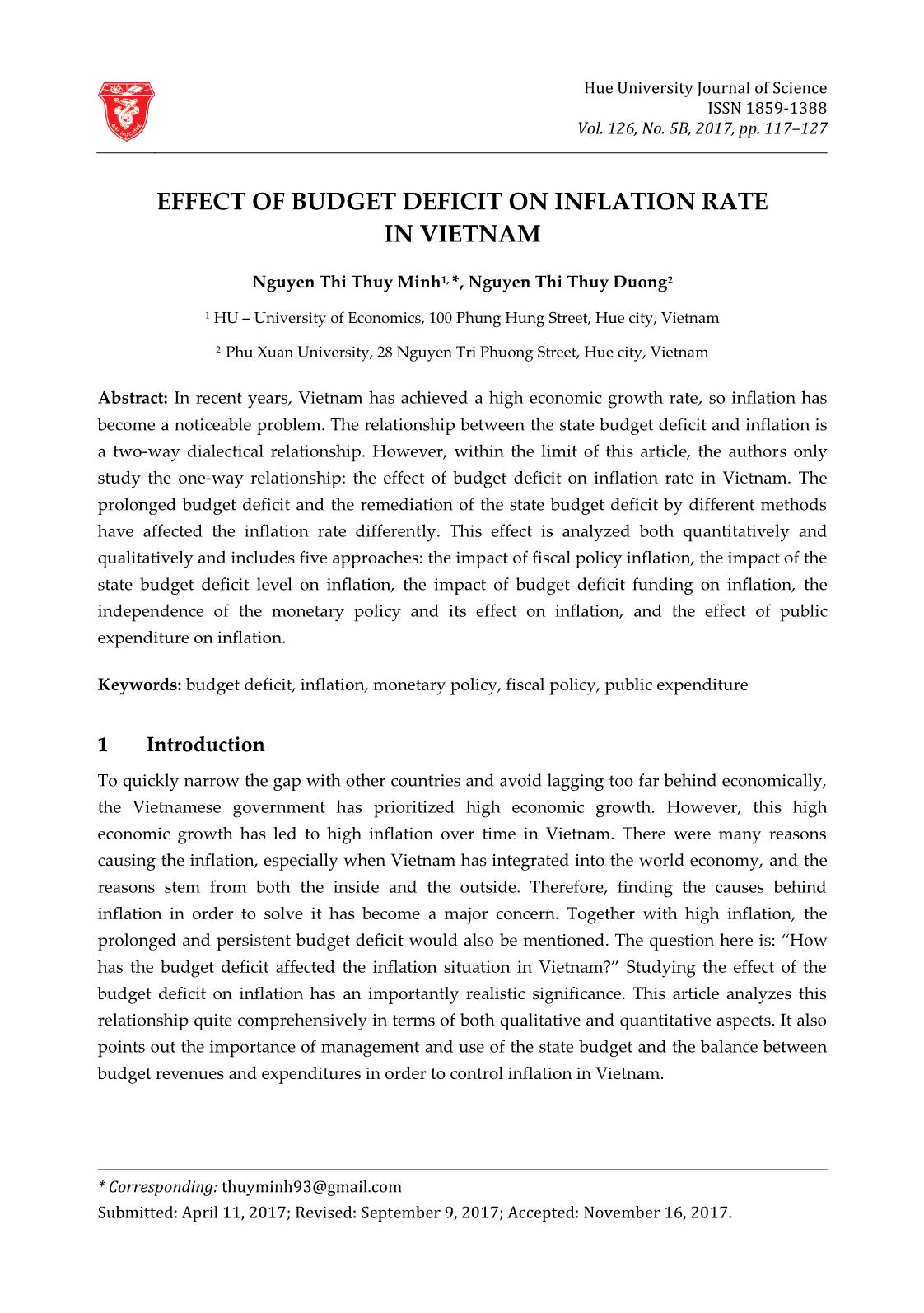
Trang 1
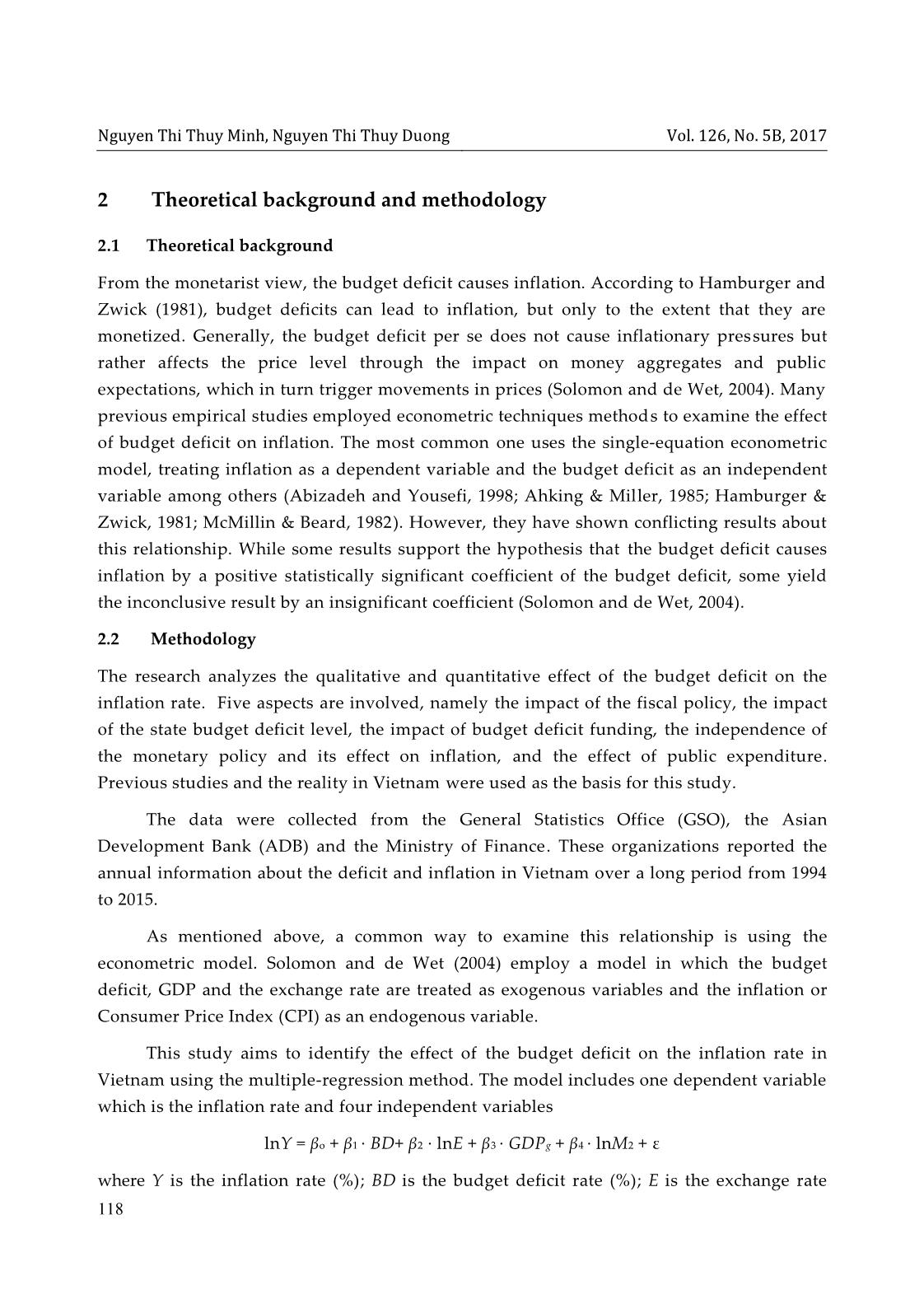
Trang 2
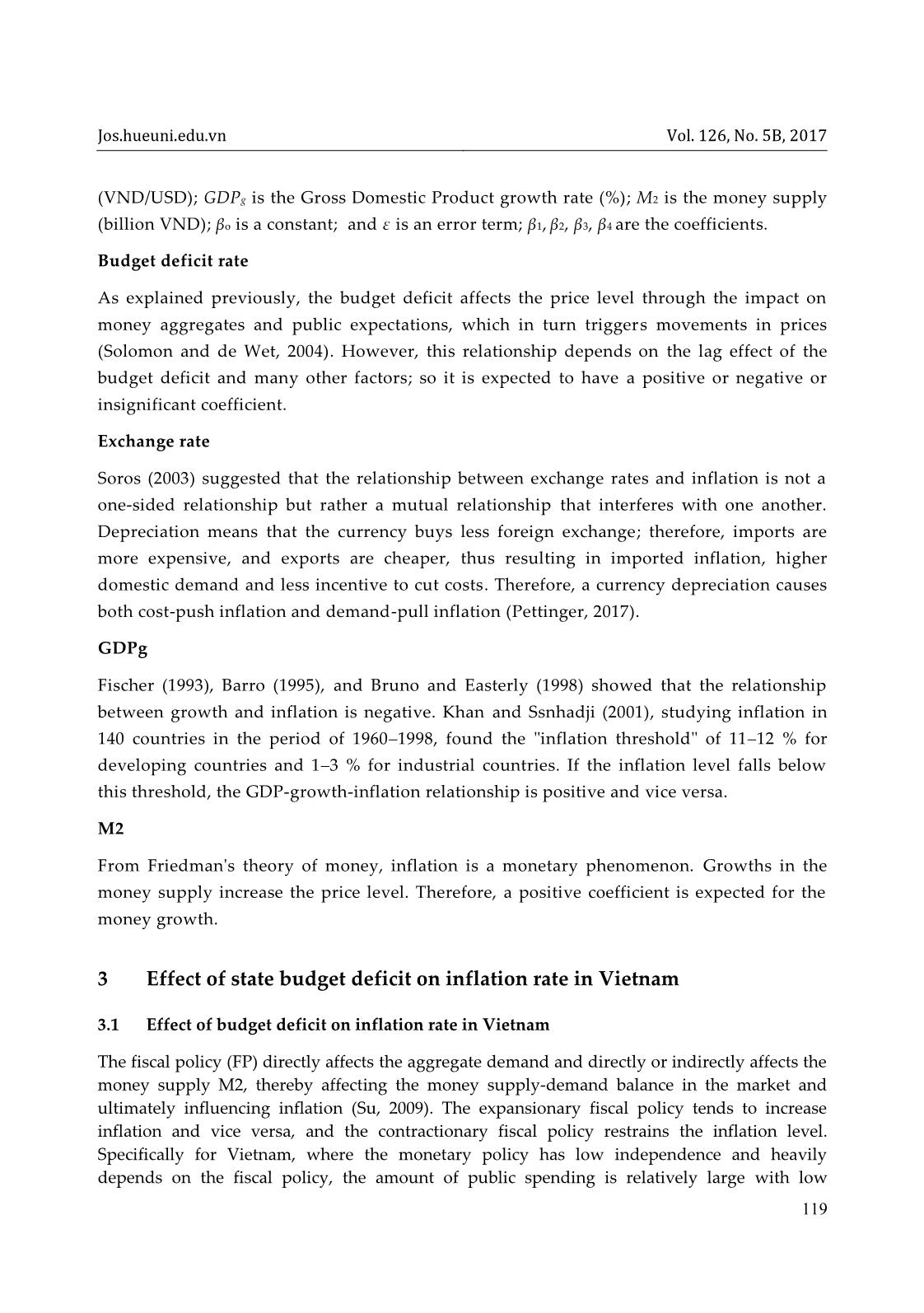
Trang 3
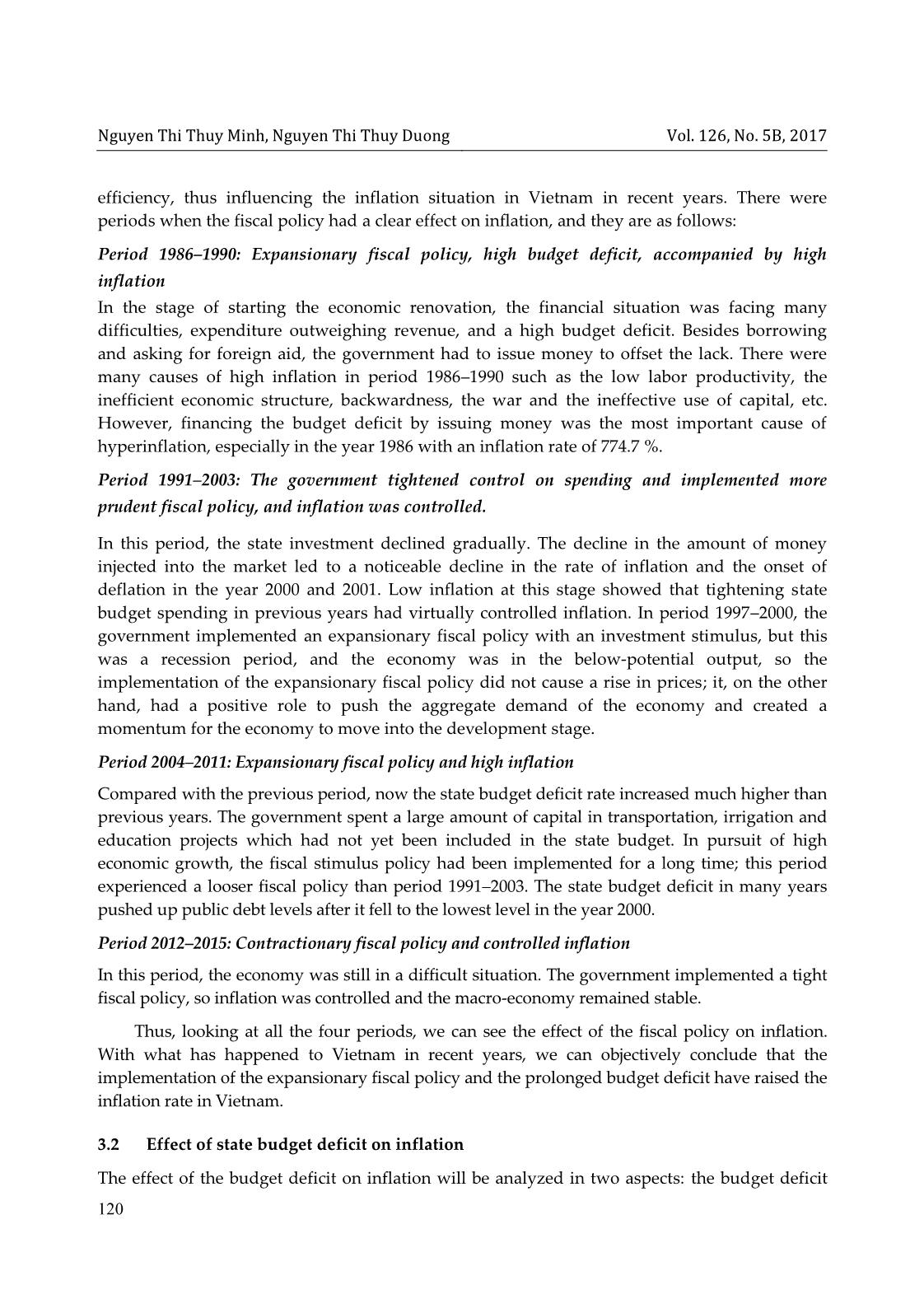
Trang 4
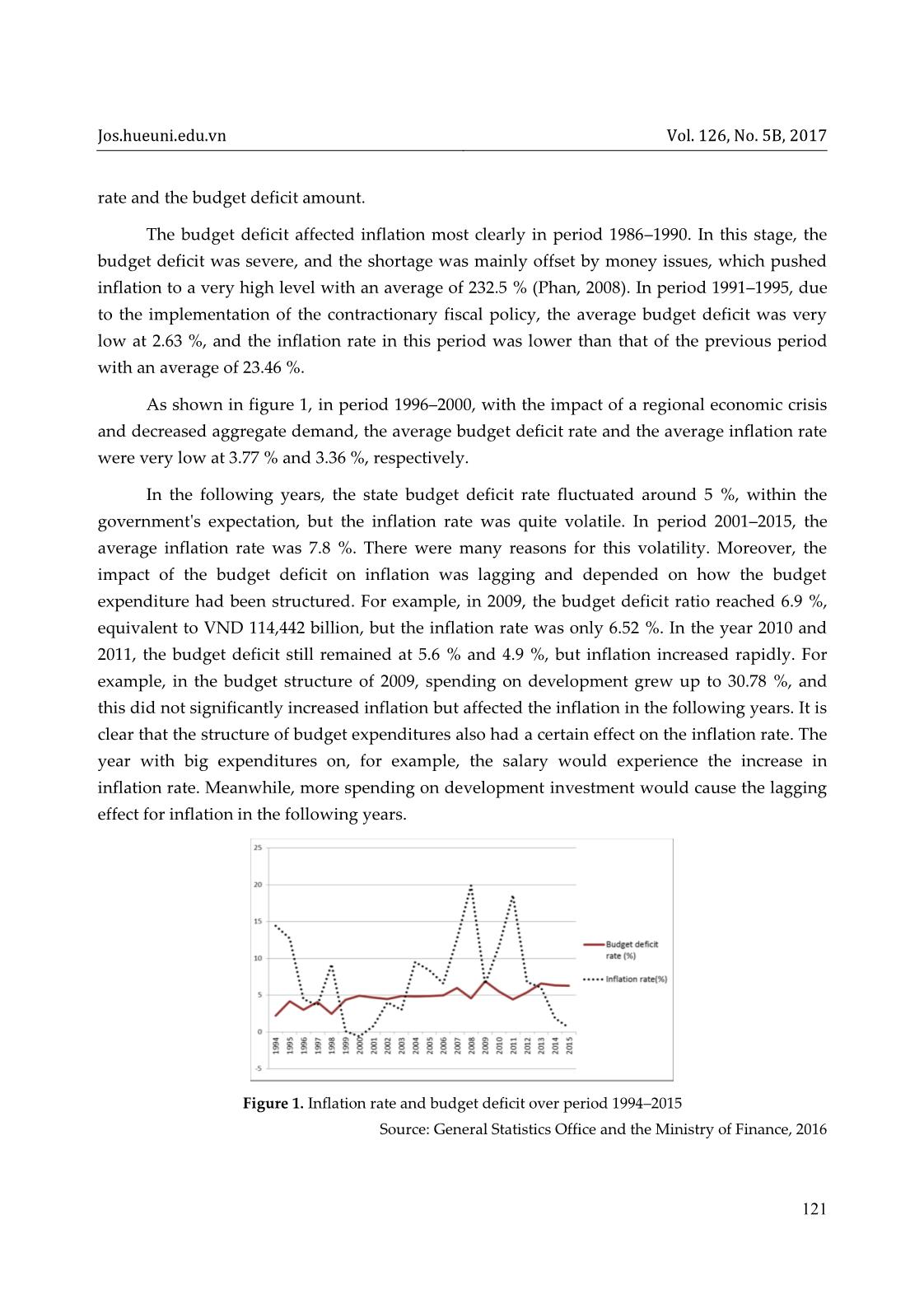
Trang 5
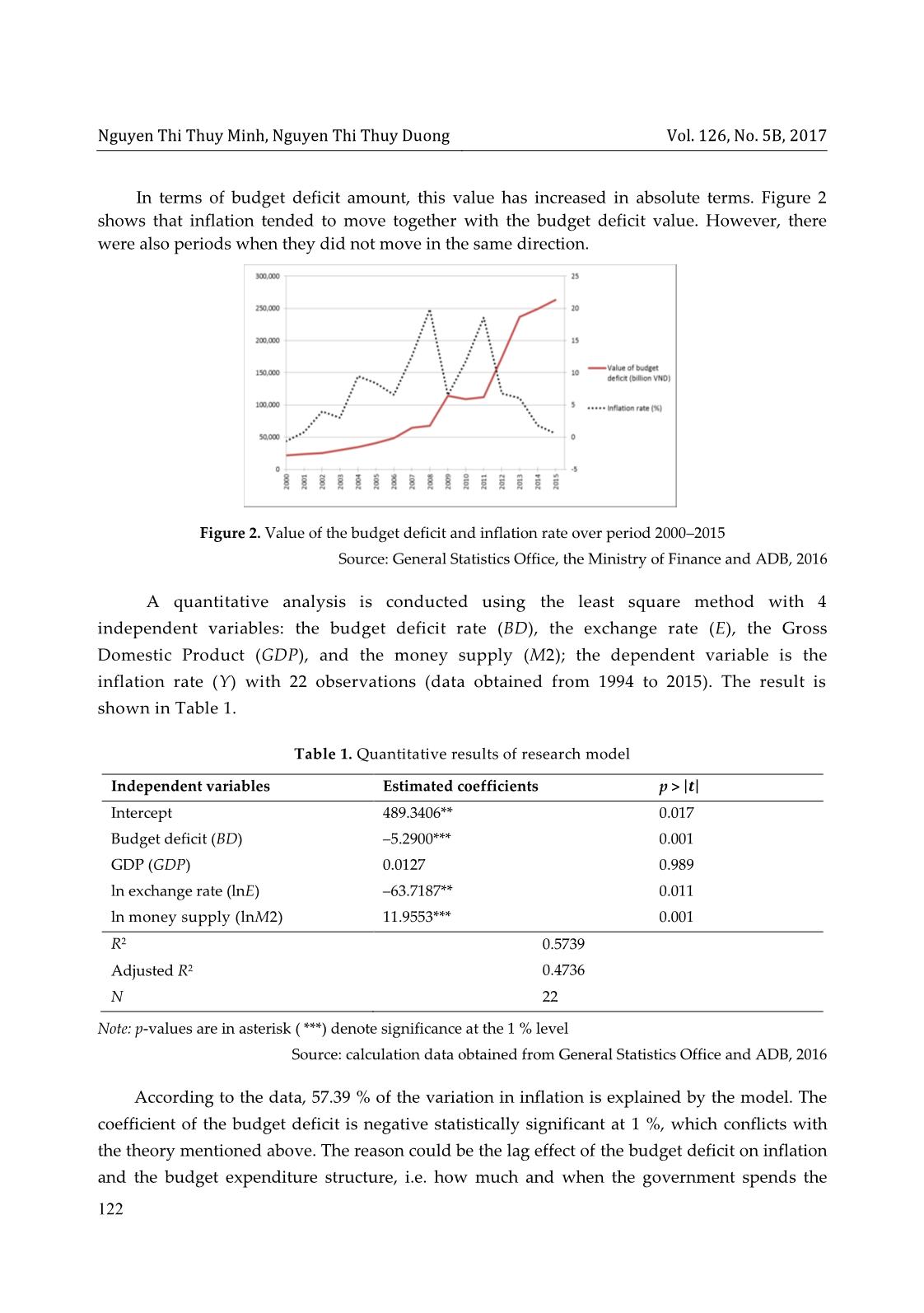
Trang 6
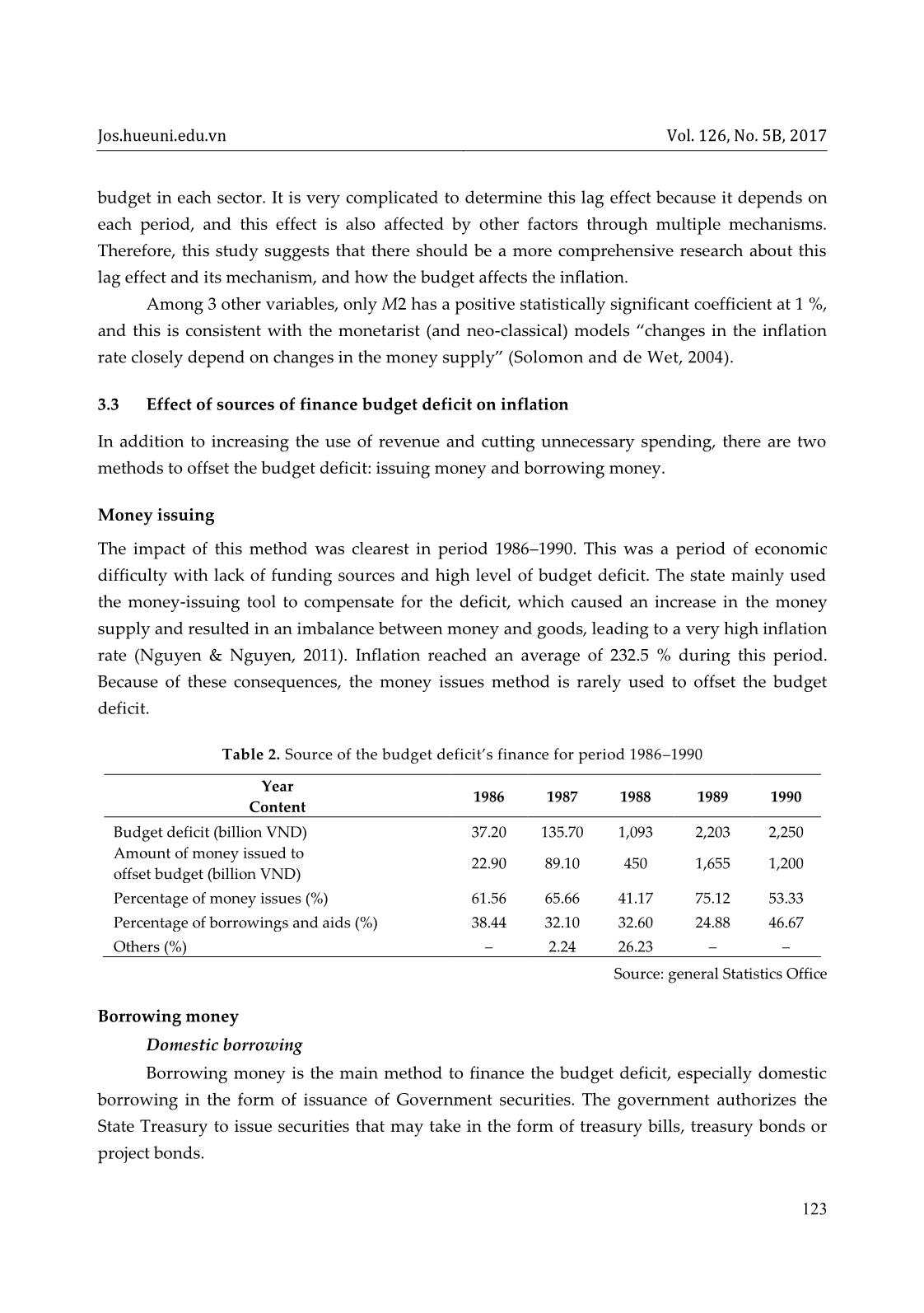
Trang 7
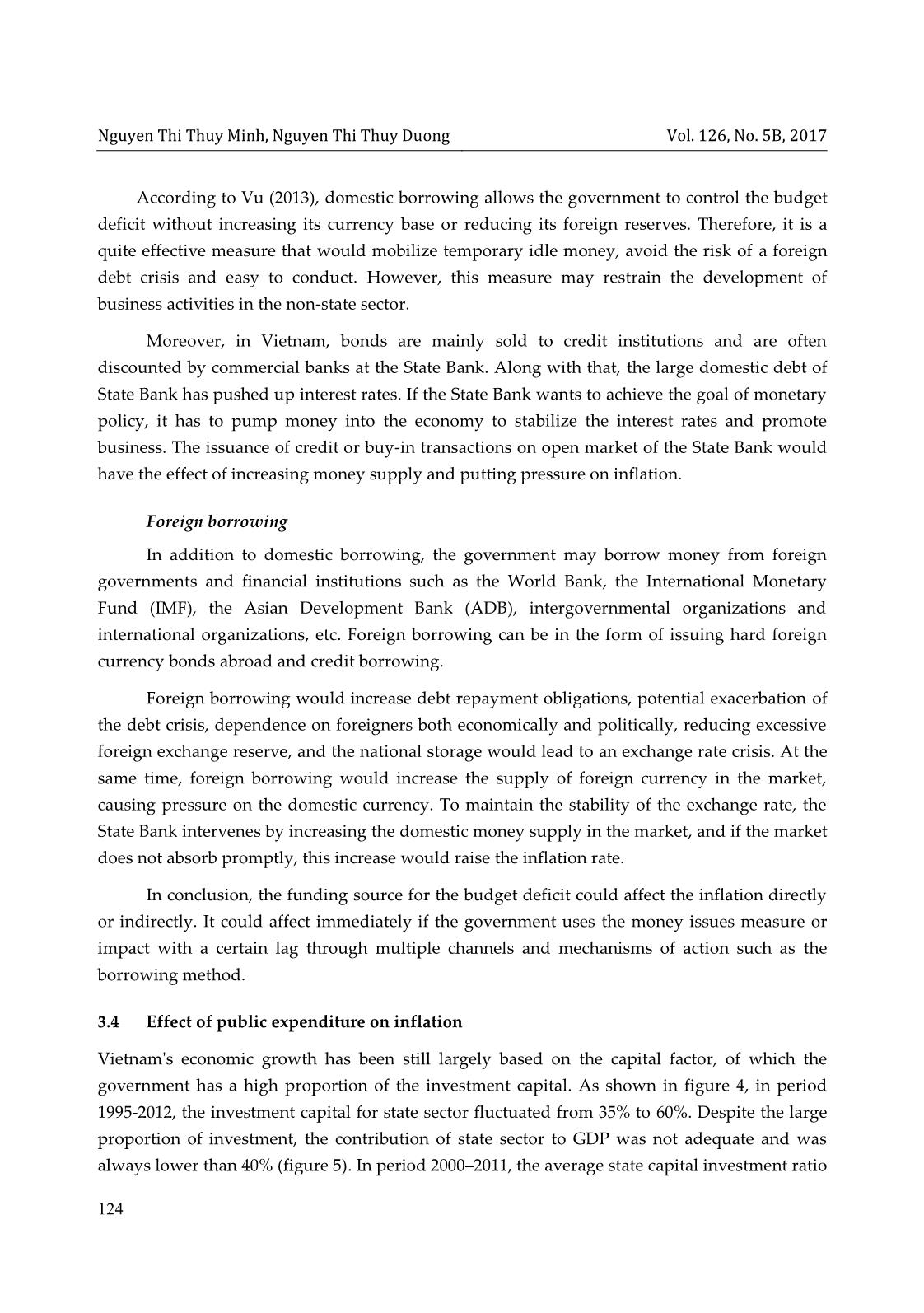
Trang 8
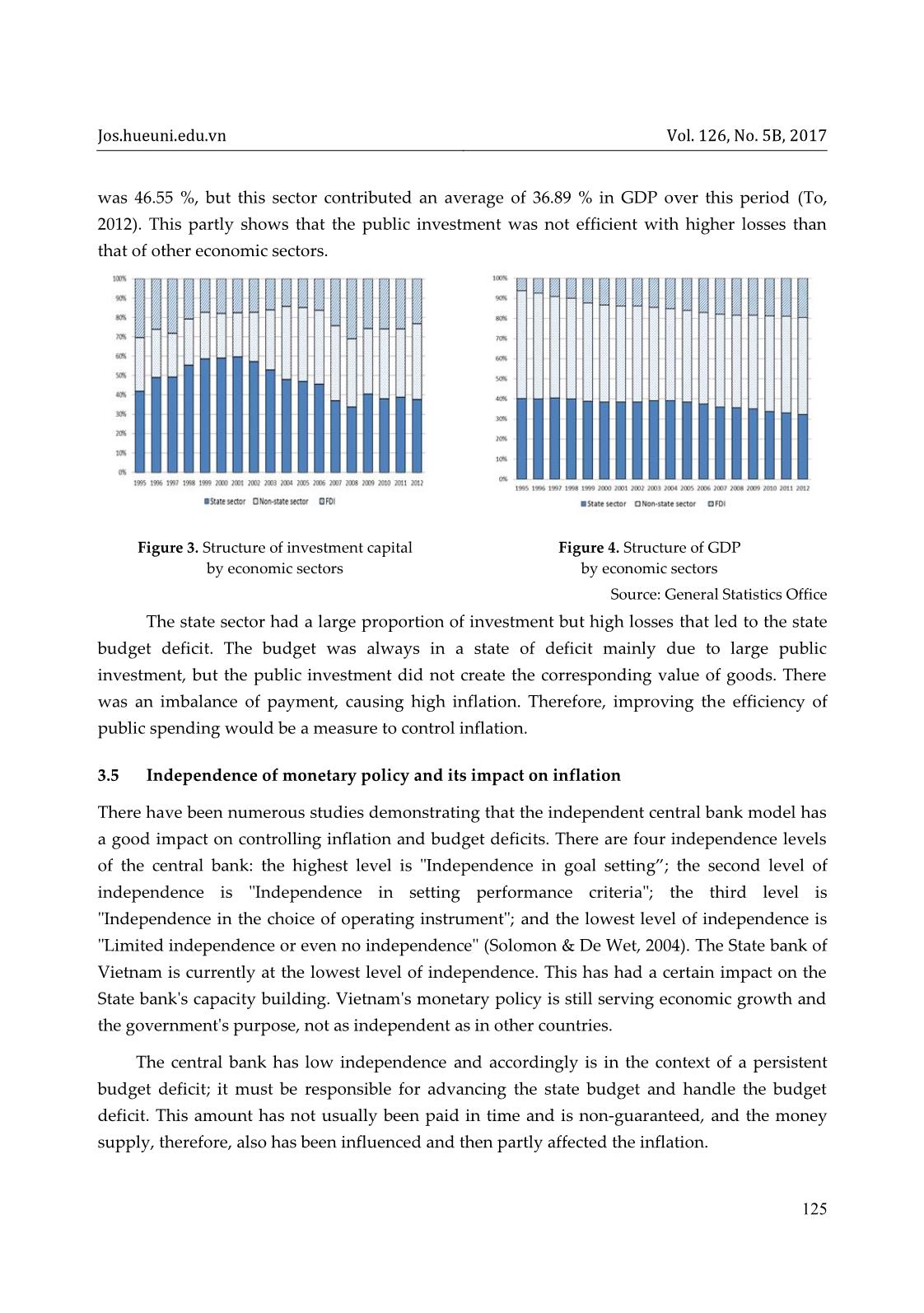
Trang 9
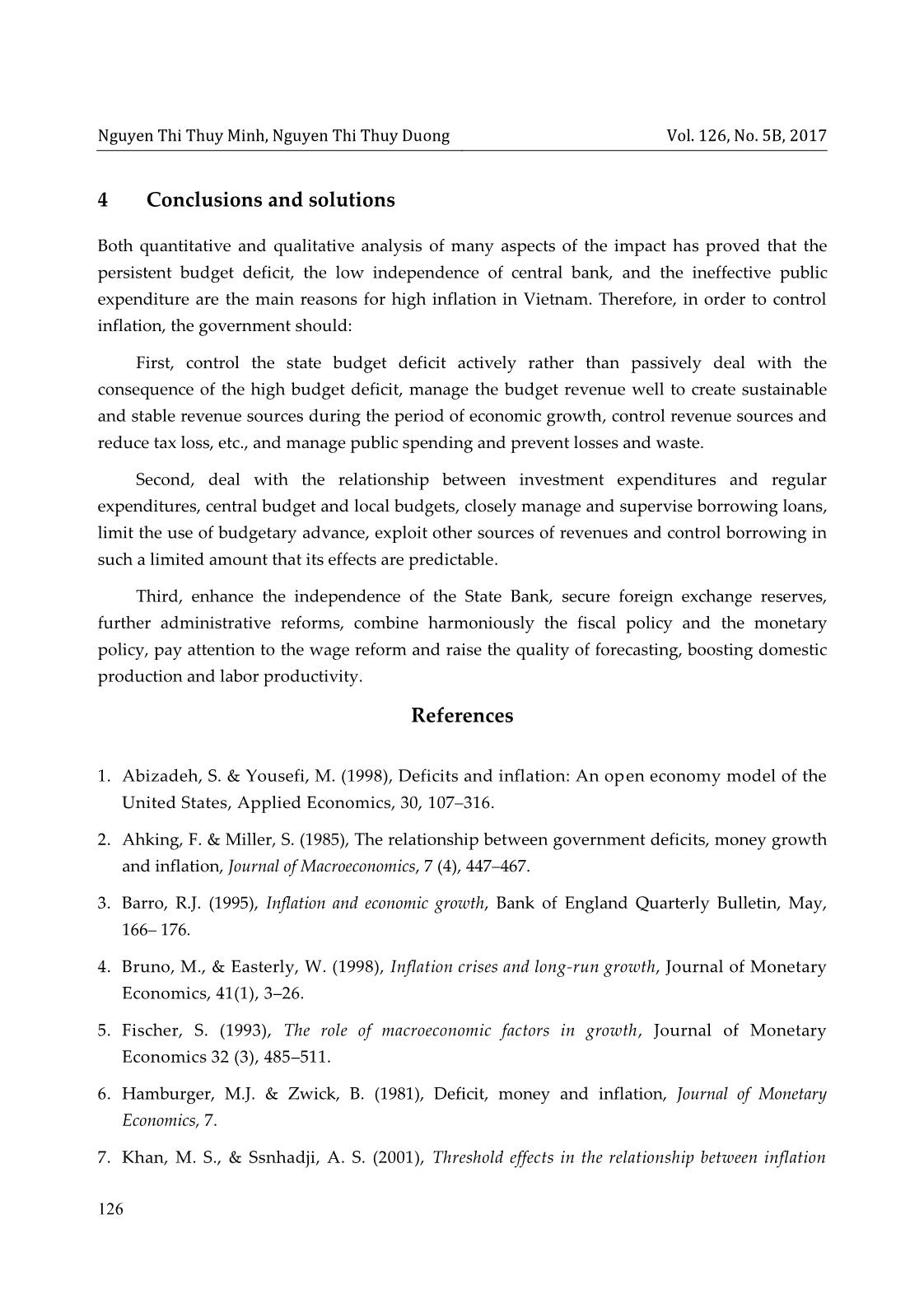
Trang 10
Tải về để xem bản đầy đủ
Tóm tắt nội dung tài liệu: Effect of budget deficit on inflation rate in Vietnam
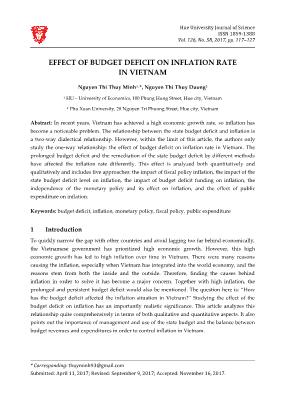
Hue University Journal of Science ISSN 1859-1388 Vol. 126, No. 5B, 2017, pp. 117–127 EFFECT OF BUDGET DEFICIT ON INFLATION RATE IN VIETNAM Nguyen Thi Thuy Minh1, *, Nguyen Thi Thuy Duong2 1 HU – University of Economics, 100 Phung Hung Street, Hue city, Vietnam 2 Phu Xuan University, 28 Nguyen Tri Phuong Street, Hue city, Vietnam Abstract: In recent years, Vietnam has achieved a high economic growth rate, so inflation has become a noticeable problem. The relationship between the state budget deficit and inflation is a two-way dialectical relationship. However, within the limit of this article, the authors only study the one-way relationship: the effect of budget deficit on inflation rate in Vietnam. The prolonged budget deficit and the remediation of the state budget deficit by different methods have affected the inflation rate differently. This effect is analyzed both quantitatively and qualitatively and includes five approaches: the impact of fiscal policy inflation, the impact of the state budget deficit level on inflation, the impact of budget deficit funding on inflation, the independence of the monetary policy and its effect on inflation, and the effect of public expenditure on inflation. Keywords: budget deficit, inflation, monetary policy, fiscal policy, public expenditure 1 Introduction To quickly narrow the gap with other countries and avoid lagging too far behind economically, the Vietnamese government has prioritized high economic growth. However, this high economic growth has led to high inflation over time in Vietnam. There were many reasons causing the inflation, especially when Vietnam has integrated into the world economy, and the reasons stem from both the inside and the outside. Therefore, finding the causes behind inflation in order to solve it has become a major concern. Together with high inflation, the prolonged and persistent budget deficit would also be mentioned. The question here is: “How has the budget deficit affected the inflation situation in Vietnam?” Studying the effect of the budget deficit on inflation has an importantly realistic significance. This article analyzes this relationship quite comprehensively in terms of both qualitative and quantitative aspects. It also points out the importance of management and use of the state budget and the balance between budget revenues and expenditures in order to control inflation in Vietnam. * Corresponding: thuyminh93@gmail.com Submitted: April 11, 2017; Revised: September 9, 2017; Accepted: November 16, 2017. Nguyen Thi Thuy Minh, Nguyen Thi Thuy Duong Vol. 126, No. 5B, 2017 2 Theoretical background and methodology 2.1 Theoretical background From the monetarist view, the budget deficit causes inflation. According to Hamburger and Zwick (1981), budget deficits can lead to inflation, but only to the extent that they are monetized. Generally, the budget deficit per se does not cause inflationary pressures but rather affects the price level through the impact on money aggregates and public expectations, which in turn trigger movements in prices (Solomon and de Wet, 2004). Many previous empirical studies employed econometric techniques methods to examine the effect of budget deficit on inflation. The most common one uses the single-equation econometric model, treating inflation as a dependent variable and the budget deficit as an independent variable among others (Abizadeh and Yousefi, 1998; Ahking & Miller, 1985; Hamburger & Zwick, 1981; McMillin & Beard, 1982). However, they have shown conflicting results about this relationship. While some results support the hypothesis that the budget deficit causes inflation by a positive statistically significant coefficient of the budget deficit, some yield the inconclusive result by an insignificant coefficient (Solomon and de Wet, 2004). 2.2 Methodology The research analyzes the qualitative and quantitative effect of the budget deficit on the inflation rate. Five aspects are involved, namely the impact of the fiscal policy, the impact of the state budget deficit level, the impact of budget deficit funding, the independence of the monetary policy and its effect on inflation, and the effect of public expenditure. Previous studies and the reality in Vietnam were used as the basis for this study. The data were collected from the General Statistics Office (GSO), the Asian Development Bank (ADB) and the Ministry of Finance. These organizations reported the annual information about the deficit and inflation in Vietnam over a long period from 1994 to 2015. As mentioned above, a common way to examine this relationship is using the econometric model. Solomon and de Wet (2004) employ a model in which the budget deficit, GDP and the exchange rate are treated as exogenous variables and the inflation or Consumer Price Index (CPI) as an endogenous variable. This study aims to identify the effect of the budget deficit on the inflation rate in Vietnam using the multiple-regression method. The model includes one dependent variable which is the inflation rate and four independent variables lnY = βo + β1 · BD+ β2 · lnE + β3 · GDPg + β4 · lnM2 + ε where Y is the inflation rate (%); BD is the budget deficit rate (%); E is the exchange rate 118 Jos.hueuni.edu.vn Vol. 126, No. 5B, 2017 (VND/USD); GDPg is the Gross Domestic Product growth rate (%); M2 is the money supply (billion VND); βo is a constant; and ε is an error term; β1, β2, β3, β4 are the coefficients. Budget deficit rate As explained previously, the budget deficit affects the price level through the impact on money aggregates and public expectations, which in turn triggers movements in prices (Solomon and de Wet, 2004). However, this relationship depends on the lag effect of the budget deficit and many other factors; so it is expected to have a positive or negative or insig ... d rapidly. For example, in the budget structure of 2009, spending on development grew up to 30.78 %, and this did not significantly increased inflation but affected the inflation in the following years. It is clear that the structure of budget expenditures also had a certain effect on the inflation rate. The year with big expenditures on, for example, the salary would experience the increase in inflation rate. Meanwhile, more spending on development investment would cause the lagging effect for inflation in the following years. Figure 1. Inflation rate and budget deficit over period 1994–2015 Source: General Statistics Office and the Ministry of Finance, 2016 121 Nguyen Thi Thuy Minh, Nguyen Thi Thuy Duong Vol. 126, No. 5B, 2017 In terms of budget deficit amount, this value has increased in absolute terms. Figure 2 shows that inflation tended to move together with the budget deficit value. However, there were also periods when they did not move in the same direction. Figure 2. Value of the budget deficit and inflation rate over period 2000–2015 Source: General Statistics Office, the Ministry of Finance and ADB, 2016 A quantitative analysis is conducted using the least square method with 4 independent variables: the budget deficit rate (BD), the exchange rate (E), the Gross Domestic Product (GDP), and the money supply (M2); the dependent variable is the inflation rate (Y) with 22 observations (data obtained from 1994 to 2015). The result is shown in Table 1. Table 1. Quantitative results of research model Independent variables Estimated coefficients p > | | Intercept 489.3406** 0.017 Budget deficit (BD) –5.2900*** 0.001 GDP (GDP) 0.0127 0.989 ln exchange rate (lnE) –63.7187** 0.011 ln money supply (lnM2) 11.9553*** 0.001 R2 0.5739 Adjusted R2 0.4736 N 22 Note: p-values are in asterisk ( ***) denote significance at the 1 % level Source: calculation data obtained from General Statistics Office and ADB, 2016 According to the data, 57.39 % of the variation in inflation is explained by the model. The coefficient of the budget deficit is negative statistically significant at 1 %, which conflicts with the theory mentioned above. The reason could be the lag effect of the budget deficit on inflation and the budget expenditure structure, i.e. how much and when the government spends the 122 Jos.hueuni.edu.vn Vol. 126, No. 5B, 2017 budget in each sector. It is very complicated to determine this lag effect because it depends on each period, and this effect is also affected by other factors through multiple mechanisms. Therefore, this study suggests that there should be a more comprehensive research about this lag effect and its mechanism, and how the budget affects the inflation. Among 3 other variables, only M2 has a positive statistically significant coefficient at 1 %, and this is consistent with the monetarist (and neo-classical) models “changes in the inflation rate closely depend on changes in the money supply” (Solomon and de Wet, 2004). 3.3 Effect of sources of finance budget deficit on inflation In addition to increasing the use of revenue and cutting unnecessary spending, there are two methods to offset the budget deficit: issuing money and borrowing money. Money issuing The impact of this method was clearest in period 1986–1990. This was a period of economic difficulty with lack of funding sources and high level of budget deficit. The state mainly used the money-issuing tool to compensate for the deficit, which caused an increase in the money supply and resulted in an imbalance between money and goods, leading to a very high inflation rate (Nguyen & Nguyen, 2011). Inflation reached an average of 232.5 % during this period. Because of these consequences, the money issues method is rarely used to offset the budget deficit. Table 2. Source of the budget deficit’s finance for period 1986–1990 Year 1986 1987 1988 1989 1990 Content Budget deficit (billion VND) 37.20 135.70 1,093 2,203 2,250 Amount of money issued to 22.90 89.10 450 1,655 1,200 offset budget (billion VND) Percentage of money issues (%) 61.56 65.66 41.17 75.12 53.33 Percentage of borrowings and aids (%) 38.44 32.10 32.60 24.88 46.67 Others (%) – 2.24 26.23 – – Source: general Statistics Office Borrowing money Domestic borrowing Borrowing money is the main method to finance the budget deficit, especially domestic borrowing in the form of issuance of Government securities. The government authorizes the State Treasury to issue securities that may take in the form of treasury bills, treasury bonds or project bonds. 123 Nguyen Thi Thuy Minh, Nguyen Thi Thuy Duong Vol. 126, No. 5B, 2017 According to Vu (2013), domestic borrowing allows the government to control the budget deficit without increasing its currency base or reducing its foreign reserves. Therefore, it is a quite effective measure that would mobilize temporary idle money, avoid the risk of a foreign debt crisis and easy to conduct. However, this measure may restrain the development of business activities in the non-state sector. Moreover, in Vietnam, bonds are mainly sold to credit institutions and are often discounted by commercial banks at the State Bank. Along with that, the large domestic debt of State Bank has pushed up interest rates. If the State Bank wants to achieve the goal of monetary policy, it has to pump money into the economy to stabilize the interest rates and promote business. The issuance of credit or buy-in transactions on open market of the State Bank would have the effect of increasing money supply and putting pressure on inflation. Foreign borrowing In addition to domestic borrowing, the government may borrow money from foreign governments and financial institutions such as the World Bank, the International Monetary Fund (IMF), the Asian Development Bank (ADB), intergovernmental organizations and international organizations, etc. Foreign borrowing can be in the form of issuing hard foreign currency bonds abroad and credit borrowing. Foreign borrowing would increase debt repayment obligations, potential exacerbation of the debt crisis, dependence on foreigners both economically and politically, reducing excessive foreign exchange reserve, and the national storage would lead to an exchange rate crisis. At the same time, foreign borrowing would increase the supply of foreign currency in the market, causing pressure on the domestic currency. To maintain the stability of the exchange rate, the State Bank intervenes by increasing the domestic money supply in the market, and if the market does not absorb promptly, this increase would raise the inflation rate. In conclusion, the funding source for the budget deficit could affect the inflation directly or indirectly. It could affect immediately if the government uses the money issues measure or impact with a certain lag through multiple channels and mechanisms of action such as the borrowing method. 3.4 Effect of public expenditure on inflation Vietnam's economic growth has been still largely based on the capital factor, of which the government has a high proportion of the investment capital. As shown in figure 4, in period 1995-2012, the investment capital for state sector fluctuated from 35% to 60%. Despite the large proportion of investment, the contribution of state sector to GDP was not adequate and was always lower than 40% (figure 5). In period 2000–2011, the average state capital investment ratio 124 Jos.hueuni.edu.vn Vol. 126, No. 5B, 2017 was 46.55 %, but this sector contributed an average of 36.89 % in GDP over this period (To, 2012). This partly shows that the public investment was not efficient with higher losses than that of other economic sectors. Figure 3. Structure of investment capital Figure 4. Structure of GDP by economic sectors by economic sectors Source: General Statistics Office The state sector had a large proportion of investment but high losses that led to the state budget deficit. The budget was always in a state of deficit mainly due to large public investment, but the public investment did not create the corresponding value of goods. There was an imbalance of payment, causing high inflation. Therefore, improving the efficiency of public spending would be a measure to control inflation. 3.5 Independence of monetary policy and its impact on inflation There have been numerous studies demonstrating that the independent central bank model has a good impact on controlling inflation and budget deficits. There are four independence levels of the central bank: the highest level is "Independence in goal setting”; the second level of independence is "Independence in setting performance criteria"; the third level is "Independence in the choice of operating instrument"; and the lowest level of independence is "Limited independence or even no independence" (Solomon & De Wet, 2004). The State bank of Vietnam is currently at the lowest level of independence. This has had a certain impact on the State bank's capacity building. Vietnam's monetary policy is still serving economic growth and the government's purpose, not as independent as in other countries. The central bank has low independence and accordingly is in the context of a persistent budget deficit; it must be responsible for advancing the state budget and handle the budget deficit. This amount has not usually been paid in time and is non-guaranteed, and the money supply, therefore, also has been influenced and then partly affected the inflation. 125 Nguyen Thi Thuy Minh, Nguyen Thi Thuy Duong Vol. 126, No. 5B, 2017 4 Conclusions and solutions Both quantitative and qualitative analysis of many aspects of the impact has proved that the persistent budget deficit, the low independence of central bank, and the ineffective public expenditure are the main reasons for high inflation in Vietnam. Therefore, in order to control inflation, the government should: First, control the state budget deficit actively rather than passively deal with the consequence of the high budget deficit, manage the budget revenue well to create sustainable and stable revenue sources during the period of economic growth, control revenue sources and reduce tax loss, etc., and manage public spending and prevent losses and waste. Second, deal with the relationship between investment expenditures and regular expenditures, central budget and local budgets, closely manage and supervise borrowing loans, limit the use of budgetary advance, exploit other sources of revenues and control borrowing in such a limited amount that its effects are predictable. Third, enhance the independence of the State Bank, secure foreign exchange reserves, further administrative reforms, combine harmoniously the fiscal policy and the monetary policy, pay attention to the wage reform and raise the quality of forecasting, boosting domestic production and labor productivity. References 1. Abizadeh, S. & Yousefi, M. (1998), Deficits and inflation: An open economy model of the United States, Applied Economics, 30, 107–316. 2. Ahking, F. & Miller, S. (1985), The relationship between government deficits, money growth and inflation, Journal of Macroeconomics, 7 (4), 447–467. 3. Barro, R.J. (1995), Inflation and economic growth, Bank of England Quarterly Bulletin, May, 166– 176. 4. Bruno, M., & Easterly, W. (1998), Inflation crises and long-run growth, Journal of Monetary Economics, 41(1), 3–26. 5. Fischer, S. (1993), The role of macroeconomic factors in growth, Journal of Monetary Economics 32 (3), 485–511. 6. Hamburger, M.J. & Zwick, B. (1981), Deficit, money and inflation, Journal of Monetary Economics, 7. 7. Khan, M. S., & Ssnhadji, A. S. (2001), Threshold effects in the relationship between inflation 126 Jos.hueuni.edu.vn Vol. 126, No. 5B, 2017 and growth, IMF Staff papers, 48 (1), 1–21. 8. Mcmillin, W. & V. Beard, T. (1982), Deficits, money and inflation: Comment, Journal of Monetary Economics, 10, 273–277. 9. Nguyen, T. T. H., Nguyen, D. T. (2011), Sources of inflation in Vietnam in period 2000–2010: New findings from new evidences (in Vietnamese), Vietnam Institute for Economic and Policy Research (VEPR). < nam-giai-doan-2000-2010-phat-hien-moi-tu-nhung-bang-chung-moi/25141.html> 10. Pettinger, T. (2017), Inflation and Exchange Rates, Economics Help,<https://www.economicshelp.org/blog/1605/economics/higher-inflation-and- exchange-rates/>. 11. Phan, T. C. (2008), Inflation in Vietnam and flexible control solutions (in Vietnamese). GTHUONG/18.%20dienbienlamphat_PhanThiCuc.pdf. 12. Solomon, M., De Wet, W. A. (2004), The effect of a budget deficit on inflation: The case of Tanzania, South African Journal of Economic and Management Sciences, 7 (1), 100–116. 13. Soros, G. (2003), The alchemy of finance, 27–45, 69–80, John Wiley & Sons. 14. Su, D. T. (2009), Fiscal policy and the problem of stabilizing the economic cycle in Vietnam (In Vietnamese), Economic development review, 221 (3). 15. To, T. T. (2012), Government investment dominates private investment? Perspective from the VECM experimental model (in Vietnamese), Vietnam Institute for Economic and Policy Research (VEPR). < dau-tu-tu-nhan-goc-nhin-tu-mo-hinh-thuc-nghiem-vecm/25107.html>. 16. Vu, M. L. (2013), Public debt crisis in some economies: causes, evolutions, consequences, remedies and policy implications for Vietnam (in Vietnamese), Vietnam Institute for Economic and Policy Research (VEPR). < nen-kinh-te-tren-the-gioi-nguyen-nhan,-dien-bien,-hau-qua,-bien-phap-khac-phuc-va- nhung-ham/25572.html>. 127
File đính kèm:
 effect_of_budget_deficit_on_inflation_rate_in_vietnam.pdf
effect_of_budget_deficit_on_inflation_rate_in_vietnam.pdf

